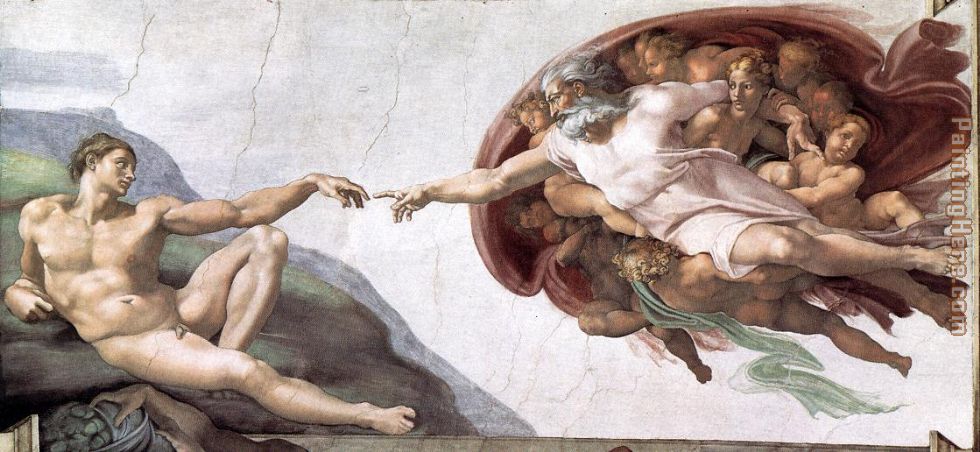So lets start with the Session I Prelude. These are the interactive pieces at the end of each chapter. This next piece comes directly from the Omnibus I textbook.
The Mystery of Michelangelo's Creation of Man:

This is the famous fresco painting by Michelangelo that is on the ceiling of the Sistine Chapel. It shows the creation of man spoken in Genesis. This, of course, shows very unbiblical picture of God. He is not a grey haired, old man. The cherubim are not pudgy little babies. This, however, is not the controversial part. Look behind God. One character is not like the others. Just under Gods left arm is a beautiful woman (who is not like the cherubs). Artists and art historians dispute her identity.
Also if you read further on in the book it talks about how her likeness is completely different than that of Eve from another fresco painting in the chapel.
My first assignment is to write a paragraph explaining who this woman is. If you are reading...who would you say she is? After really thinking about I think I might know. But then again I could be completely wrong.
Next come the Comprehension Questions which I will list and the answer.
1. When and by whom was Genesis written?
It is believed that Moses is the author of Genesis and wrote this book in the 1400's B.C. This belief is based on three main ideas: 1. Being the prince of Egypt, he would naturally have access to many written records, 2. Moses was very well educated and had the ability to write and articulate what he learned and 3. Jesus and the apostles assumed that he wrote it (Matt. 8:4, Mark 7:10, John 1:17, 7:22, Acts 3: 22, Rom . 10:5). And Jesus is never wrong, so it must have been Moses.
2. What does the word Genesis mean?
The word, Genesis means beginning(s).
3. How would one divide Genesis into a two part outline?
There are two main sections to the book of Genesis. If one were to write an outline for them they should include primeval history and then the second section chronicles the beginning of God's redemptive program through a single family. How they would go about that would largely depend on personal preference, in my opinion.
4. What purpose does the word toledoth serve in Genesis? What does it mean?
Toledoth means "These are the generations of....". The text of Genesis is centered around ten section that all begin with the word toledoth. I believe the purpose of this word is to show the connection of each family listed. To show of whom and where from the generations that God used to fulfill His plan.
5. Make a list of things we learn about God from the book of Genesis.
We learn that God is:
Personal
Sovereign
Covenantal
and Merciful
6. Why did the Fall introduce a distinction between what man is as the image of God and what man ought to be?
Man was meant to be a reflection of God (not God, but privileged with the likeness of God). When Man fell he lost his ability to perfectly reflect the image of God. Now, just like a broken mirror, man produces a distorted image of some that is beautiful.
7. What is a covenant? With whom did God enter into a covenant in Genesis?
In the bible a covenant was a promise. This deal, promise, whatever other word that fits the bill, was made by cutting the an animal in half and laying them side by side. The two making the covenant then walked in between the two halves of the animal while repeating their contract with one another. This basically (although there's nothing basic about it) said that I do this or die. God made a covenant with Adam, Noah and Abraham in the book of Genesis.
Now is when you go to the comment section and give your thoughts and ideas. Have fun. And thanks :]



0 comments:
Post a Comment